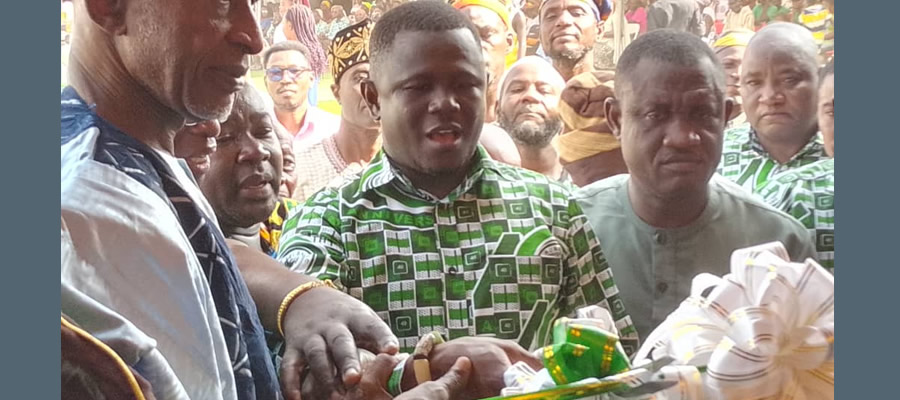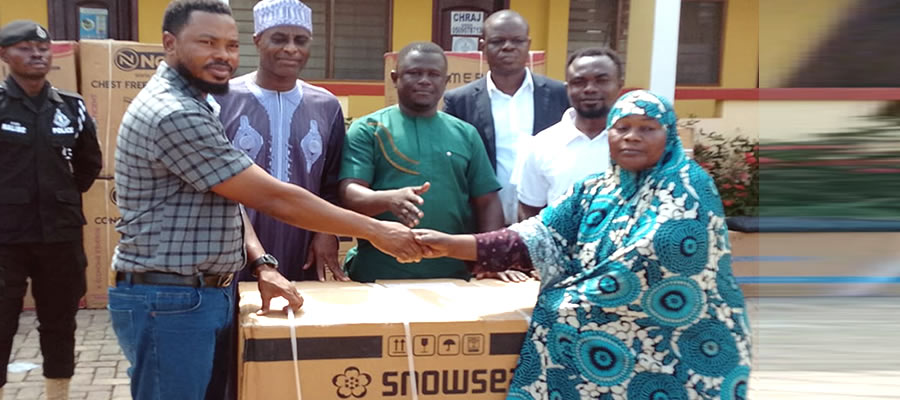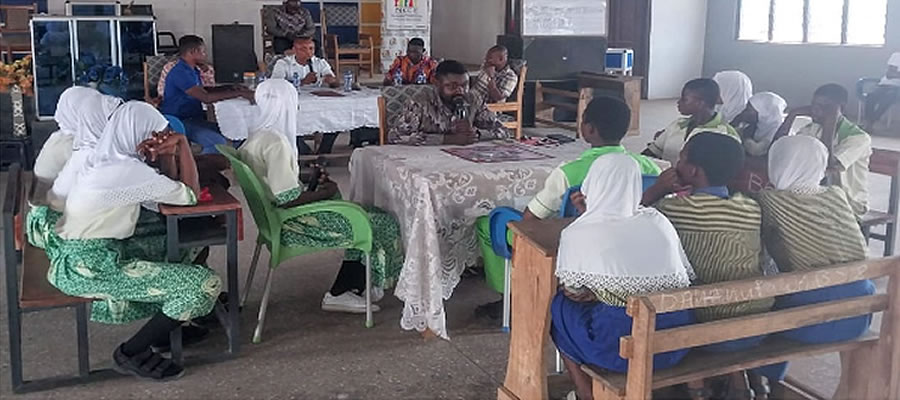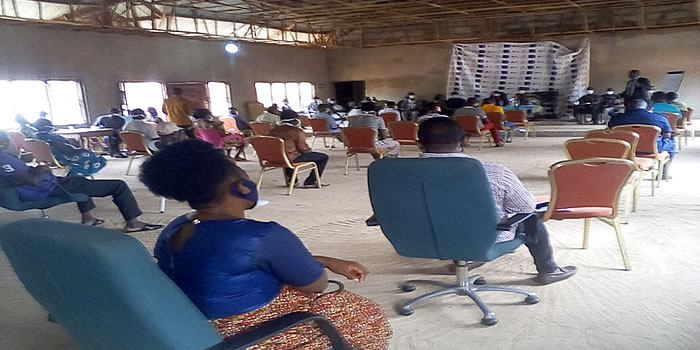

Population Size and Growth Rates
The District has an estimated population of 73,508 (estimated 2018) with a relatively high growth rate of 3.0% which is higher than the regional and national growth rates of 2.5% and 2.7% respectively. Out of this population figure, males accounted for 38,224(52%) and females 35,284 (48%). The entire population of the district constituted about 3.0% of the regional estimated population of about 2,787,048.
The high population growth rate of the district can be attributed to a number of factors including the large influx of settler farmers and fishermen from the three (3) Northern Regions, Volta, Accra, the opening up of the area by the Kumasi-Ejura-Atebubu High way and the natural increase resulting from high birth rate and low infant mortality rate.
This trend of population growth have a negative effect on environment since Agric arable lands are being reduced and degraded for settlements, which when not given necessary attention is likely to result in desertification and environmental degradation in the District. The Forestry Department and other stakeholders therefore need to be supported to effectively monitor and sensitize the people to protect our natural resources from the ravages of population pressure.
Age and Sex Composition
According to the 2010 Population and Housing Census, the district has a relatively large male population compared to that of female. This structure is not different from that of the Brong Ahafo Region where the district is located. It however differs from that of the national sex structure which shows a female dominance. The sex ratio, male to female is 103.8 compared to the regional of 105.1. The large male population trend in the district is partly due to the continuous influx of settler farmers and fishermen who come into the district to tap the districts agricultural and economic potentials. It has been observed that most of these settler farmers if not all are males.
Source: DPCU, PWDA, 2018
The District has a large youthful population. The two cohorts that contain most of the people are the 0 – 14 group which constitute 42.9 and the 15 – 64 group which also forms 51.3% 65+ forms only 4.3%. The age structure depicts that the district has a large labour force (51.3%) while the regional and national active labour force are 52.4% and 55.2% respectively. This large active labour force could be positioned to harness and maximize the vast agricultural potentials and motivated groups to grow more trees to improve the vegetation of the district.
Household Composition
The composition and structure of the households reflects the general social structure of the society. According to extracts from the 2010 PHC, the average household size is 5.6 compared to the regional average of 4.6.
Dependency Ratio
Statistics from the 2010 PHC shows the district has a relatively high dependency ration. The total age dependency ratio (dependent population to population in the working age) for the District is 92.04, the age dependency ratio for males is higher (96.27) than that of females (87.84). This means that approximately 100 persons in the productive ages have 92 persons to care for in the dependent population. The district has child dependency ratio of 85.5 while that of the aged ones is 6.5. The child dependency ratio is high because there is a high proportion of the population 14 years or less, who are still dependent on the productive age group. The dependency ratio for the urban area is 77.37 whiles that of the rural areas is101.82.
Population Density
The increase in population over time is reflected in the high population densities for the period 1970, 1984 2000 and 2010. In 2010, the population density stood at 40.1 per km sq. With a static land size of 2,093kmsq and ever dynamic population, this means there is great pressure on the district?s fragile environment and other resources, which if care or pragmatic measures are not taken may gradually result in environmental degradation.
Settlements such as Prang, Zabrama, Komfourkrom, Abease, Buom, Adjaraja/Beposo, Cherembo, among others are growth points which continue to accommodate relatively higher population densities with corresponding pressure exerted on existing limited infrastructure facilities. This trend has led to the development of slums in the urban town (Prang) with its attendant socio-economic effects. Table 1.1 below shows the population trends from 1970 to 2010.
Rural/Urban Split
The population of the district is basically rural, with about 63% of the people residing in rural areas. The remaining of the population can be found in major towns of the district like Prang, Zabrama, Abease and Komfourkrom. Table 1.2 below illustrates the population of the district, by type of locality and sex.
Population distribution is uneven with the only urban and other most populous localities in the district constituting about 58.11% of the total population of the district. Prang the district capital, alone constituted about 14.31% of the population
Spatial Distribution of Population
The district contains a total of 88 localities; most of the populated localities are located along the main roads from Prang to Kintampo through Abease. Prang is the only urban locality according to the 2010 PHC with a population of 10,248. This may be partly due to the concentration of most of the social amenities in the area at the expense of the less populated ones. Therefore, there is the need to evenly distribute socio-economic facilities to other smaller communities to help them grow.
The Abease Area Council holds about two thirds of the total land area in the district and contains most of the rural population.
Table 11: Area Councils and their Settlements in the District
Figure 1.7: Spatial Distribution of Population by Settlement in the District
MIGRATION (EMIGRATION AND IMMIGRATION)
Migration trend in Pru West District shows that 26.70 percent migrated into the district. The high rate of immigration is attributed to the vast and arable land of the district, agricultural activities continues to serve as pull factor for settler and migrant populations mostly from northern part of Ghana. The survey revealed that, 60% of the total migrant population is from the three Northern regions of Ghana (Northern, Upper West, Ashanti and Volta Regions). However, Northern Region leads in terms of percentage with 27.2% followed by Upper West Region 18.8% of the total migrant population.
The high in-migration has made labour cost cheaper and promoted economic activities, especially farming, fishing and trading. However, the outcome is much to be desired since the district?s limited resources, social amenities, especially sanitation are under pressure. They also have implication for security, health and environment
Key Development Issues
1. High Rural Urban migration
2. High population growth rate
3. High immigration
4. Congestion
GENDER
Gender Inequalities
Gender analysis mainly centres on men, women, boys and girls in the society. It consist of the societal roles and responsibilities of men, women, boys and girls as well as power relations between the groupings. The analysis measures the extent to which gender gaps exist among issues such as opportunities, needs, rights, voices, participation, access to resources, control of resources and decision making. It provides information on the different roles of women and men at different levels; their respective access to and control over the material and non-material benefits of society; their priorities, needs and responsibilities. It shows the linkages between inequalities at different societal levels; needs assessment is a vital component of gender analysis. Needs analysis is a necessary step when identifying appropriate strategies for the promotion of gender equality.
The roles and responsibilities of men and women are based on the various activities performed by both in the society. Men?s and women?s activities are identified as either “reproductive” or “productive” types, and these activities reflect access to and control over income and resources in society. Under productive, women are often engaged in activities which offer them little remuneration. They are mostly involved in wage labour, subsistent farming, crafts and so on. With regards to reproductive work, they are engaged in childbearing and rearing, domestic tasks that guarantee the maintenance and reproduction of the current and future work force, for example, cooking, cleaning and so on. They are also engaged in care and maintenance of the household and its members (bearing and caring for children, food preparation, water and fuel collection, shopping housekeeping and family health care). Works which are seldom considered „real work? and are usually unpaid are most at times the responsibilities of girls and women. As a result of this, women and girls have minimal access and control over resources like land, education, equipment, labour, cash from sales, extension services, training, agric inputs, irrigation, technology and credit.
On credit, both women and men have different credit needs for income generation and other expansion schemes. Women control money for small household items, but men control income for larger items; and they tend not to know about their rights in applying for loans in the communities. It is considered not feminine if women ask for credit. Men generally own land and other fixed capital. One needs to be able to read and write to fill the loan forms, and there tend to be more illiterate men than women. Women have low self-esteem and view men in lending institutions and also in NGOs as „superior?.
Gender Equality
Development programmes and projects affect females and males differently and therefore it is important for development organizations to understand the cultural milieu of their project societies to ensure that their interventions produce equitable outcomes and impacts for females and males.
The gender distribution of the population shows that females account for 48 percent of the district population (2010 PHC, GSS), which translates into a sex ratio of 103.8, i.e., about 103 males to 100 females, i.e., females are about two percent less than males. In spite of the percentage of female in the district population, they have very low representation when compared to males in decision making institutions in the district. Females representation in the country such as traditional councils, district assemblies and parliament mainly occupy low positions of employment in the district.
In terms of traditional leadership, males dominate. For instance, all the two Traditional Councils are occupied by males while females are designated queen mothers. Also, majority of the subchiefs chiefs of the divisional and almost all their „Odikro? are males.
Regarding political representation at the national and local government levels, the district is largely represented by males. At the beginning of the implementation of the Fourth Republican Constitution in 1992, the Pru West Constituency has had males as members of parliament since its creation in 2012. While at the district assembly level female assembly members accounted for only 16 percent (Appointed) of the total number of 18 assembly members for the period 2017 – 2019. In terms of elected representation, out of the 12 elected assembly members in the 2015 district level election none of them were females. Out of the 6 Government Appointees only one is a female. This means that 16 of government appointees and 5% of the General Assembly members are females. This shows that the electorates are not electing as many women as men or that women unlike men are not offering themselves for elections. Women therefore remain largely outside the decision making structures of the district. It is obvious that their concerns will not only be well articulated but will be considered one of the general issues that affect males and females and therefore solutions provided will be one fit for all which may lead to low impact on women.
Economically, females are greatly found in occupations such as agriculture, forestry, or fishing and service and sales, which are significantly found in the informal sector of the district economy and are characterized by low and unreliable incomes. According to the 2010 PHC results 53.6 percent of the employed female population 15 years and older are employed as agricultural, forestry or fishery workers while 19.1 percent are employed in manufacturing.
Females are also overburdened with their inherited traditional roles of reproduction, production and household chores, which increase their vulnerability.
Gender dimensions should therefore be considered for all programmes and projects to ensure that women contribute meaningfully to the development processes in the district.
The district will seek to increase the representation of women in decision making at the Assembly level and also provide alternative livelihood activities for women engaged in farming and micro and small scale business.
Societal Roles of Men, Women, Boys and Girls
Gender roles are basically the different tasks, responsibilities and expectations the society has defined and allocated to men, women, boys and girls. Generally, three (3) major gender roles can be identified; reproductive, productive and community management roles. These roles are not different from the roles identified in the District from the findings of a study undertaken by the DPCU.
Reproductive roles involve the care and maintenance of the household and its members including food preparation, water and fuel collection, shopping, housekeeping and family care. Reproductive roles include child bearing and rearing responsibilities for both men and women. However, women and girls perform the bulk of reproductive tasks considering its importance of human survival. This role is often time consuming, labor-intensive and places some limitations on women participation in other activities. The importance of this role cannot be down scored, therefore the need to design and deliver basic social services for women to facilitate the continuous play of this role.
Community management roles involve the collective organization of social events, maintaining family links, managing council resources, developing community infrastructure, makingdecisions for the community and ensuring that the household support each other. Women ensure that basic resources are available for the household, including cooking, cleaning and healing. Maintaining cleanliness of the community, preparing places and foods for festivals, funerals and other communal events are assigned to women and children. This has been perceived to be an extension of domestic work. Women are responsible for allocating the limited resources, services and infrastructure to achieve optimal results. However, local political activities which involve participation in public decision-making in the district favors men compared to women. Women, men, boys and girls are likely to be involved in all three broad areas of roles. In the district, however, women do almost all of the reproductive and much of the productive work.
Any intervention in one area will affect the other areas. Women?s? work load can prevent them from participating in development projects. When they do participate, extra time spot farming, producing, training or meeting means less time for other tasks such as child care or food preparation. Table 1.28 below shows the defined societal roles and responsibilities, needs and interests of the various gender groups identified in the district.
Access to and Control over Resources and Benefits
Gender roles also affect how men and women have access to and control over resources, benefits and decision-making. Having access means having the opportunity to use a resource or influence a decision but it does not mean having control over it.
Productive, reproductive and community management roles all require the use resources. Availability of resources to women engaged in work usually generates benefits for individuals, households, the communities and the District at large. The gender and development approach to development requires sensitivity to women?s access to the resources needed for their work, their control over those resources to use as they wish, their access to the benefits gained from family and personal work, and to the control they have over the benefits.
Resources such as land, equipment, tools, labour, cash/credit, employable/income earning skills, employment, leadership, education and information, self-confidence and credibility and time are generally critical but scarce for women.
In the District, women have access to most of the resources they use to perform their roles, but no control over them. For instance, women have access to land, food, income, local political processes but no control over ownership, its allocation, how it can be spent and little influence and control over the nature of issues to be addressed and final decisions.
A study conducted reveals that access to and control of the District resources is skewed towards men. However, further disaggregation of the data shows, women control most of the productive roles (petty trading, fish smoking etc) are dominated by women. The Assembly therefore has to promote these sub-sectors to help bridge the gap in other roles especially in community management roles and political roles.
Spatial Dimensions of Poverty
Based on differences in geographical location, nature and severity of poverty and other factors “pockets of poverty” were carved out. These pockets show the spatial dimensions of the incidence of poverty in the district. A description of the pockets is presented in Table....
Key Development Issues
1. Low female representation in decision making
2. Low female access to land
3. Low access of women to credit facilities
4. Inadequate awareness on rights
SETTLEMENT SYSTEMS
Introduction
This section discusses the spatial organization of the settlement system in the district. It provides a summary of the socio-economic profile, access within a spatial context and further shows the type, number, destination of facilities and services and how these factors ultimately shape the hierarchy of settlements in the district
Functional Hierarchy of Settlements
Analysis of the distribution of facilities and service using some combined settlement systems techniques show that facilities and services are not evenly distributed within the district. The tools used are the Scalogram and the settlement distance matrix. The distance matrix depicts the travel distance in terms of kilometers between the major settlements in the District. However, the Scalogram indicates the services within some major communities in the District. The analysis is based on the assumption that people would access the nearest service. For instance the analysis indicates that people of Kamampa travel to Cherembo to access education because it the nearest in terms of physical distance. Again the analysis established that Prang offers the most number of functions in the district and can thus be termed first order settlement. Second order settlements would include Zabrama and Abease. Third order settlements, for the purpose of this analysis include Komfourkrom and others which have been classified as no order settlements.
Figure 1.8: Functional Hierarchy of Settlements
Table 13: Settlement Distance Matrix of the District
Table 14: SCALOGAM ANALYSIS OF MAJOR TOWNS
Commodity Flows
Pru West district engages in trade with various marketing centres within and outside the Brong Ahafo Region. Among districts that patronise the Pru West markets are Kumasi, Kintampo North Municipal, and Atebubu,. Commodities that flow from the district to its trading partners are basically agricultural produce. Usual produce are yam, cassava, charcoal, fish, cattle and sheep. On a usual market day, these items are sold to buyers from all over the country. The District also gets manufactured goods from Kumasi, Atebubu, Kintampo and Yeji. These range from household provisions to construction materials, automobiles, consumables, to telecommunication gadgets. This is a clear indication that the district economy is not diversified to harness the raw materials that abound.
Inter and Intra District Trade
There is a high degree of internal trade among communities within the District. This is so because many small communities do not offer marketing functions for patrons who want to exchange their produce for money in other to purchase other consumables. Major trading centers are Prang, Abease and Zabrama. They offer varying degrees of marketing opportunities for all market players. Usually the relationship is such that people from remote rural areas convey their agricultural produce to market centres and other marketing centres in exchange of purchase consumables, spare parts and inputs back home.
Date Created : 7/6/2023 12:00:00 AM










 facebook
facebook
 twitter
twitter
 Youtube
Youtube
 +233 593 831 280
+233 593 831 280 0800 430 430
0800 430 430 GPS: GE-231-4383
GPS: GE-231-4383 info@ghanadistricts.com
info@ghanadistricts.com Box GP1044, Accra, Ghana
Box GP1044, Accra, Ghana